An analysis of bumblebee wings from a network of UK museums shows signs of stress linked to increasingly hotter and wetter conditions.
As well as revealing what is linked to stress in bees in the past, the study can help predict when and where bees will face most stress and potential decline in the future. Bumblebees and other insects are important natural pollinators of crops and of wildflowers, but many groups have faced population declines in recent years.
Using digital images, the group first investigated the asymmetry in bumblebee wings as an indicator of stress. High asymmetry (very differently shaped right and left wings) indicates the bees experienced stress during development – an external factor that affected their normal growth.
Studying four UK bumblebee species, the group found evidence for stress getting higher as the century progressed from its lowest point around 1925. Further analysis showed that each bee species displayed a consistently higher proxy of stress in the latter half of the century.
Read more at Imperial College London
Image: Bumblebee specimens in the collections of the Natural History Museum, London (Credit: Trustees of the Natural History Museum, London)


